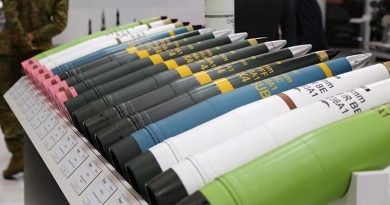MAD delivery for Warramunga on Ex Kakadu

It was an unusual day for HMAS Warramunga, sailing around northern Australia as part of Exercise Kakadu.
CAPTION: The stores dropped by the RAAF C-27J Spartan are craned onto HMAS Warramunga’s deck during Exercise Kakadu 24. Story by Lieutenant Marie Davies. Photo by Midshipman Joshua Breedon.
At approximately 10.30am, a securely wrapped 100kg package containing essential stores was loaded onto a C-27J Spartan at RAAF Base Darwin.
Then 45 minutes later, the package was hurtling towards the ocean with a parachute in tow.
The replenishment pallet splashed safely into the sea, 300m off the starboard side of Warramunga.
Nearby, a strategically placed rigid hull inflatable boat waited patiently to recover the stores and deliver them to the ship.
CAPTION: Able Seaman Boatswains Mate Ginael Dongo observes HMAS Warramunga’s sea boat collect a resupply dropped by a RAAF C-27J Spartan. Photo by Leading Seaman Iggy Roberts.
Maritime Logistics Officer Lieutenant Commander Chris McLaughlan explained this was a ‘maritime aerial delivery’ or MAD.
“MAD allows us as logisticians to get key stores items to ships at sea without the need to come within helicopter range of the coast or go back alongside to a port,” Lieutenant Commander McLaughlan said.
“This means the ship can remain on task for much longer and give our engineers the chance to recover equipment.
“It’s also really useful if there isn’t a friendly port nearby.”
CAPTION: A RAAF C-27J Spartan drops a 100kg package during a replenishment at sea activity with HMAS Warramunga. Photo by Midshipman Joshua Breedon.
Following the MAD, the crew conducted a ‘rotors-running refuel’ of an MH-60R helicopter in readiness for a combined air and surface exercise with aircraft and ships from Australia, India, Indonesia, Japan and Singapore.
Their goal? To hunt down one of the Royal Australian Navy’s stealthy assets – Collins-class submarine, HMAS Dechaineux.
Once detected, India’s P8 fixed-wing aircraft simulated a torpedo strike to end the exercise.
The evening involved a surface activity where Task Group One – consisting of Australian, Japanese, Indonesian and Singaporean warships – worked together, force-on-force, simulating a Harpoon missile strike against Task Group Two, comprising Canada’s HMCS Vancouver and the US’s USS Dewey.
Exercise Kakadu, now in its 16th iteration and supported by the Royal Australian Air Force, provides an opportunity for regional partners to conduct multinational maritime activities. It draws together about 3000 personnel, ships from 10 countries and aircraft from five to Darwin and the Northern Australian Exercise area.
.
.

.
.







